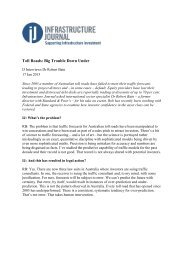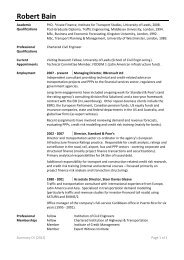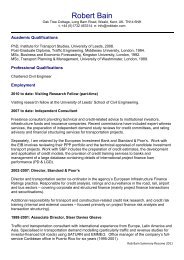Disincentivising overbidding for toll road concessions
Disincentivising overbidding for toll road concessions
Disincentivising overbidding for toll road concessions
- No tags were found...
You also want an ePaper? Increase the reach of your titles
YUMPU automatically turns print PDFs into web optimized ePapers that Google loves.
2 │ LITERATURE REVIEW<br />
21<br />
Literature review<br />
This section contains a review of the academic literature surrounding the problem of <strong>overbidding</strong> in transport<br />
infrastructure projects. It begins by outlining the nature and incidence of the observed <strong>overbidding</strong> problem<br />
(section 2.1), be<strong>for</strong>e analysing its potential root causes, including the winner’s curse, optimism bias and strategic<br />
misrepresentation (section 2.2). Sub-sections 2.2.4 to 2.2.8 present the factors that are likely to have an impact on<br />
the incentives <strong>for</strong> bidders to strategically misrepresent their <strong>for</strong>ecasts. Finally, some potential solutions that have<br />
been put <strong>for</strong>ward in the literature are evaluated (section 2.3).<br />
2.1 The problem<br />
In the context of the construction and operation of many infrastructure assets, such as <strong>toll</strong> <strong>road</strong>s, the market is<br />
commonly believed to operate more effectively when competition is introduced at the concession award stage,<br />
rather than at the operational stage. Concessions contracting introduces competition ‘<strong>for</strong> the market’ in the <strong>for</strong>m of<br />
competitive tendering, which should have the effect of ensuring that each contract is awarded to the party, or parties,<br />
that can carry out the contracted functions most efficiently. In public–private partnerships (PPPs) this allows the<br />
taxpayer to get the best value <strong>for</strong> money.<br />
However, in tendering <strong>for</strong> construction <strong>concessions</strong>, there is evidence that firms systematically underestimate the<br />
costs that will be involved in delivering a project 6 or overestimate the demand <strong>for</strong> the finished product. 7 Both of these<br />
biases lead to cost–benefit ratios that overstate the value of the project.<br />
In the context of cost-side bias, Flyvbjerg, Holm and Buhl (2002) found that costs were underestimated in 86% of<br />
the 258 transport infrastructure projects they studied, and that actual costs exceeded estimated costs by 28%, on<br />
average. 8 The authors reported that:<br />
Estimated costs are biased, and the bias is caused by systematic underestimation… costs are not only<br />
underestimated much more often than they are overestimated or correct, costs that have been underestimated<br />
are also wrong by a substantially larger margin than costs that have been overestimated. 9<br />
6 See, <strong>for</strong> example, Pickrell, D.H. (1990), ‘Urban rail transit projects: Forecast versus actual ridership and cost’, US Department of Transportation;<br />
Flyvbjerg, B. Holm, M.S. and Buhl, S. (2002), ‘Underestimating Costs in Public Works Projects – Error or Lie’, Journal of the American Planning<br />
Association, 68:3, 279–95.<br />
7 Flyvbjerg, B. Holm, M.S. and Buhl, S. (2005), ‘How (in)accurate are demand <strong>for</strong>ecasts in public works projects The case of transportation’,<br />
Journal of the American Planning Association, 71:2, 131–46; Bain, R. (2009), ‘Error and Optimism Bias in Toll Road Traffic Forecasts’,<br />
Transportation, 36: 5, 469–82.<br />
8 Flyvbjerg et al. (2002), op. cit.<br />
9 Flyvbjerg et al. (2002), op. cit., p. 282.<br />
11






